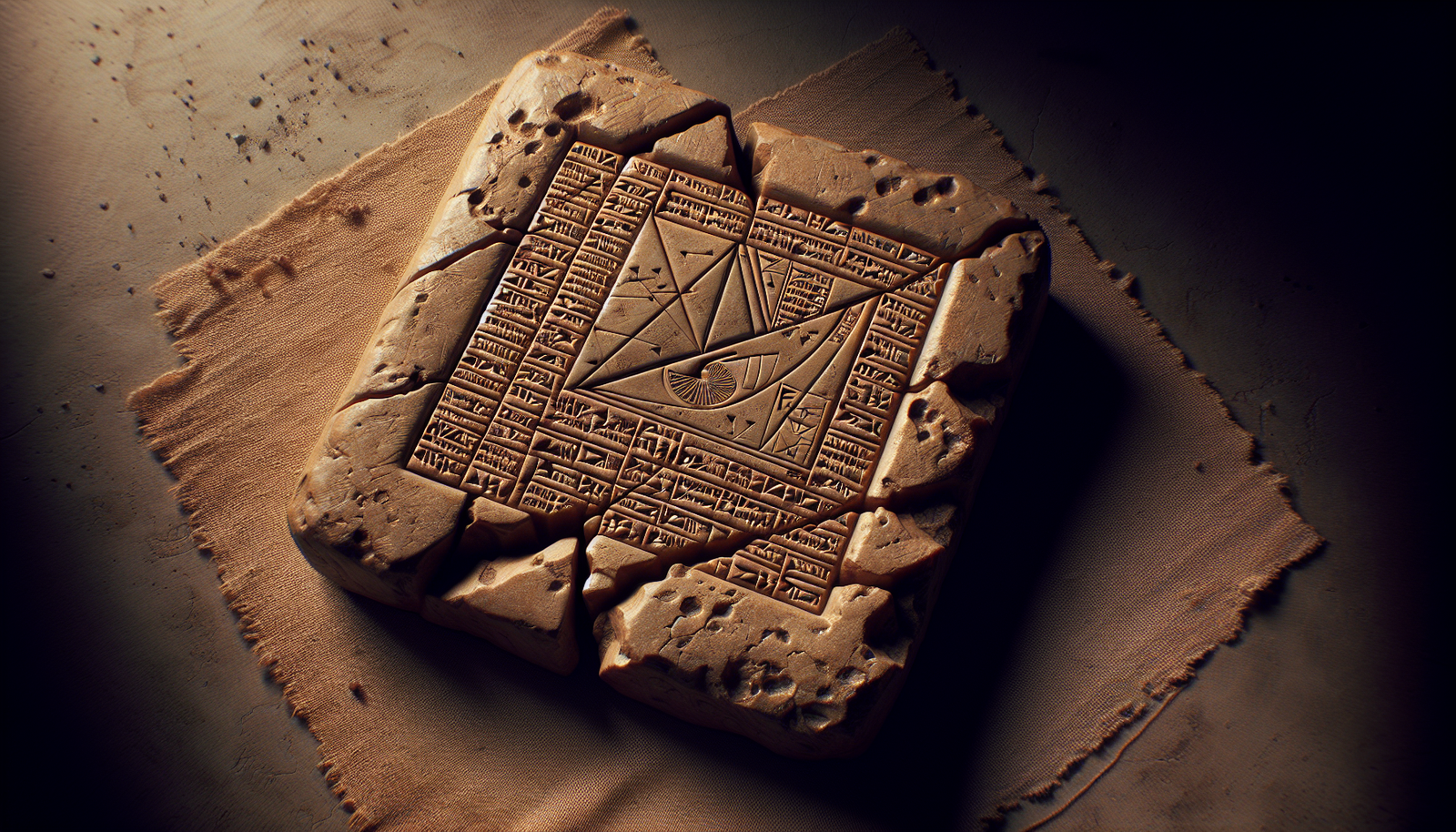The Babylonians and ETs: Gods or Star Visitors?

By Elaine Westfield, Ufologist
Picture this: an ancient civilization that calculated planetary movements with astonishing accuracy, created sophisticated astronomical models that wouldn't be matched for over a millennium, and left behind detailed accounts of powerful beings who descended from the heavens, shared knowledge with humanity, and even took select individuals up into the sky. This wasn't a civilization from our recent past, but one thriving over 4,000 years ago between the Tigris and Euphrates rivers in Mesopotamia.
Babylon, whose very name translates to "gateway of the gods," stands as perhaps humanity's most scientifically advanced early civilization. The achievements of Babylonian astronomers and mathematicians continue to amaze modern scholars, who frequently uncover new evidence of their sophisticated understanding of the cosmos. But alongside these scientific breakthroughs sits an equally rich tapestry of myths and religious texts describing interactions with celestial beings.
Could there be more to these stories than mere mythology? Did the Babylonians' extraordinary knowledge of the heavens come from something beyond their own observations? The ancient tablets themselves pose a provocative question: were the gods of ancient Babylon actually visitors from the stars?
This isn't about definitively claiming "aliens built Babylon." Rather, it's about examining specific elements in Babylonian texts and knowledge that, when viewed through a contemporary lens, display striking parallels to modern concepts of extraterrestrial contact. Let's explore what the ancient texts actually say, and why they continue to fascinate both scholars and those searching for evidence of cosmic connections in our ancient past.
The Unexpected Sophistication of Babylonian Knowledge
Babylon wasn't just any ancient city. At its height under King Nebuchadnezzar II (604-562 BCE), it was a metropolis of over 200,000 people featuring architectural marvels like the legendary Hanging Gardens, massive defensive walls, and the towering ziggurat Etemenanki. While impressive, these physical achievements pale in comparison to the intellectual breakthroughs happening within the city.
The mathematical and astronomical knowledge of the Babylonians has repeatedly forced modern scholars to revise their understanding of ancient capabilities. In 2016, researchers examining a 3,700-year-old clay tablet discovered that Babylonians were using sophisticated geometric methods to track Jupiter's movements that historians had previously believed weren't developed until 14th century Europe – a full 1,400 years later.
"It's a kind of a tour de force, teasing out the meaning from these sources," remarked Alexander Jones from New York University's Institute for the Study of the Ancient World. "What he's found is really quite remarkable."
What makes this discovery particularly striking is that the Babylonians weren't just tracking Jupiter's position – they were calculating its velocity changes over time using a technique similar to modern calculus. They created what mathematician Daniel Mansfield described as "an abstract mathematical space" by plotting velocity against time – a conceptual leap that wouldn't reappear in human history for over a millennium.
The Babylonian method for tracking Jupiter wasn't simply plotting observations. They created a trapezoid on their clay tablets where the area represented Jupiter's total displacement, and by computing various portions of this area, they could determine the planet's position at any given time. This level of abstract mathematical thinking seems wildly ahead of its time.
"They were very, very smart," noted researcher Noel Swerdlow, "and the more we learn of what they did, the more impressive, the more remarkable it becomes."
Their mathematical prowess extended far beyond Jupiter. Babylonian astronomers meticulously documented celestial events in compilations like the "Enūma Anu Enlil," which contained centuries of observations. They developed predictive models for solar and lunar eclipses, created accurate lunar calendars, and even conceptualized what we now know as the Pythagorean theorem over a thousand years before Pythagoras himself was born.
The Babylonians bequeathed to us our 60-second minute, 60-minute hour, and 360-degree circle – all products of their innovative base-60 numerical system. They could calculate square roots with remarkable accuracy and developed algorithms for estimating the square root of any number.
Their intellectual achievements weren't limited to the stars. In medicine, Babylonian physicians introduced concepts like diagnosis, prognosis, physical examination, and prescriptions. The Diagnostic Handbook, written by the scholar Esagil-kin-apli, outlines empirical observations and logical rules for diagnosing various diseases.
This unexpected sophistication raises an intriguing question posed directly in the cuneiform texts themselves: how did they acquire such knowledge? One ancient tablet puts forward a startling possibility – that their astronomical understanding came not from generations of observation alone, but from "star travelers."
The Cosmic Religion: Gods of the Celestial Realm
To understand the Babylonian relationship with the cosmos, we must first recognize that their religion was fundamentally celestial in nature. As one researcher notes, to say they "watched the sky religiously" isn't just a figure of speech – it literally describes their worldview, where "the planets as gods moved through the heavens by divine design."
Babylon itself, whose name derives from "Bab-ili" or "gateway of the gods," was conceptualized as the access point between the divine and earthly realms. The enormous ziggurat Etemenanki (meaning "house of the foundation of heaven and earth") was considered the literal connection between the cosmic and terrestrial worlds.
The Babylonian pantheon was intimately connected to celestial bodies. Marduk, elevated to supreme deity status during Hammurabi's reign, absorbed attributes of the earlier Sumerian god Enlil and became the "enlil of the gods" – essentially the president of the divine council. His temple Esagila and the associated ziggurat Etemenanki were considered the "foundation of heaven on earth."
Other major deities included Sin (the moon god), Shamash (the sun god), Ea (god of fresh waters), and Ishtar (associated with Venus). The Babylonians believed these gods physically manifested in their respective celestial bodies, making astronomy and religion inseparable practices.
This "cosmic religion" extended beyond mere observation. The New Year's Festival (Akitu) represented a cosmic reset where the gods would leave their cities, visit Marduk, and announce their plans for the coming year. During this ritual, carefully choreographed ceremonies reenacted the creation of the world, the defeat of chaos, and the restoration of order.
Perhaps most fascinating is the Babylonian understanding of Orion. Called "sipazi anna" meaning "the shepherd of Anu" or "shepherd of heaven," Orion wasn't just a constellation but a supreme being. Earlier depictions showed Orion in a "bird-like form" referred to as a "messenger" who brought communications between Earth and Orion itself.
This conception of Orion as both a physical constellation and a cosmic communicator has led some researchers to ask provocative questions: Could this be describing some form of interstellar communication device? Might these ancient texts be documenting a space station orbiting Earth, inhabited by visitors from the Orion system?
While such interpretations stretch far beyond conventional historical understanding, they highlight the way Babylonian celestial religion blurs the line between symbolic myth and descriptions of physical interaction with cosmic forces.
Gods from the Sky: Narratives of Descent and Interaction
The Babylonian creation epic, Enuma Elish, doesn't begin with "In the beginning" like Genesis, but with "When in the heights" – immediately establishing a narrative of descent from above. This story describes the "powerful beings from the skies, from space" coming down to Earth – a concept paralleled in other Mesopotamian creation myths.
This theme of celestial beings descending to interact with humanity appears repeatedly in Babylonian and broader Mesopotamian literature. The Enuma Elish mentions Asheri, "the one who brought the gift of agriculture to humanity in the deep past" – described as a positive intervention by a powerful being from above who fundamentally changed human development.
One of the most striking Mesopotamian narratives involves beings called the Egiji, described as "observers" who took a dramatic interest in human affairs. According to these texts, the Egiji "crossbreed with human females" after "seeing the daughters of men were beautiful." This hybridization story parallels the biblical account of the "Ben Elohim" (sons of the powerful ones) who took human wives and produced offspring described as "giants" and "men of renown."
These aren't subtle mythological metaphors but explicit accounts of interspecies breeding between celestial beings and humans, resulting in hybrid offspring. According to ancient historian Josephus, evidence for these giants persisted into the classical period, where they were known as "the titans of Greek legend."
Such narratives of direct intervention by sky beings in human genetic heritage feel remarkably similar to modern accounts of alleged extraterrestrial genetic experimentation. The parallel becomes even more pronounced when we consider that these ancient texts treat these events as historical occurrences rather than symbolic stories.
The Babylonian astronomical obsession suddenly takes on a different light when considered alongside these accounts. Were they tracking celestial bodies with such precision because they understood them not just as lights in the sky, but as the vehicles or homes of beings who had directly intervened in human affairs?
Celestial Tutors: The Gift of Knowledge
Beyond breeding with humans, Mesopotamian texts describe celestial beings imparting vast knowledge to early humanity. The Greek-Babylonian historian Berossus writes of beings called the Oannes (or Akcaloo) who "taught our ancestors mathematics, writing, legal systems, recordkeeping, civil engineering, agriculture and all the accoutrements of civilization."
This theme appears in the Atrahasis tablet as well, where Enlil "showed them the way to smelt iron and to work steel" and taught humans to "dig long channels and to provide food." In essence, these texts credit divine beings from the sky with bootstrapping human technological development.
Drawing from Mesopotamian sources, the Book of Enoch provides an even more detailed inventory of knowledge supposedly taught by these celestial visitors. After interbreeding with humans, they taught:
- "Charms and enchantments, and the cutting of roots, made them acquainted with plants" – essentially early medicine and pharmacology.
- "To make swords and knives and shields and breastplates" – metallurgy and weapons technology.
- "The metals of the earth and the art of working them" – mining and metalcraft.
- "Bracelets and ornaments and the use of antimony and all kinds of costly stones and all coloring tinctures" – jewelry making and cosmetics.
Different celestial teachers specialized in different domains: "Baraka taught astrology, Cockabel the constellations, Ezekiel the knowledge of the clouds, Arachiel the signs of the earth, Shamiel the signs of the sun, and Sariel the course of the moon."
This comprehensive educational program covers virtually every aspect of early civilization, from practical skills to scientific knowledge. The texts describe this as "a rich and peaceable cultural exchange in the beginning" – before it eventually led to conflict.
This narrative of knowledge transfer from advanced beings to early humans parallels modern "ancient astronaut" theories in striking ways. However, unlike many modern speculations, these accounts are actually present in the original Mesopotamian texts themselves, not imposed by later interpretations.
Skyward Journeys: Ancient Accounts of Celestial Travel
Perhaps most startling are the Mesopotamian accounts of humans being physically taken into the sky by these celestial beings. Multiple cuneiform tablets describe people being "taken up into space" by what one source explicitly calls "advanced nonhuman beings."
Two prominent examples are the myths of Adapa and King Etana. The Adapa myth, discovered on tablets from around 1800 BCE, tells of a man taken up by divine beings. The Sumerian Kings List (from the late 3rd millennium BCE) mentions King Etana who "gets taken up into the heavens or what we would call the skies into space."
These narratives find a parallel in the biblical account of Enoch, who "walked with the powerful ones until he was no longer seen on earth because the powerful ones took him away." The Book of Enoch, heavily influenced by Mesopotamian sources, expands on this brief mention with a detailed description of his heavenly journey.
Enoch writes: "Behold, in the vision, clouds invited me, and a mist summoned me. And the course of the stars and the lightning sped and hastened me. And the winds in the vision caused me to fly and lifted me upward and bore me into heaven."
His description of what he encountered is particularly fascinating: "I went in till I drew nigh to a wall which is built of crystals... and surrounded by tongues of fire... I went into the tongues of fire and drew nigh to a large house which was built of crystals. And the walls of the house were like a tessellated floor made of crystals. Its ceiling was like the path of the stars and the lightnings and between them were fiery cherubim."
This description of transparent walls, a house of crystal, and a ceiling showing stars and lightning has led some researchers to ask: "Aren't we being shown the stars of space and fiery craft moving through them?" The parallels to modern descriptions of alleged craft encounters are difficult to ignore.
Enoch describes the environment as simultaneously "hot as fire and cold as ice" with "no delights of life therein" – an apt description of the harsh conditions of space. His experience of fear and trembling upon entering this environment also matches what one might expect from a human encountering an alien environment.
Similarly, the prophet Ezekiel's famous vision shares elements with Enoch's account, particularly the description of a transparent canopy or dome. Both narratives feature individuals struggling to describe unfamiliar technology or environments using the limited vocabulary of their time.
These accounts of humans journeying to the sky long predate modern concepts of space travel, yet contain elements that resonate with contemporary understanding of spacecraft and the space environment.
Gods or Star Visitors? Interpreting the Evidence
After examining these texts, we face a fundamental question: are we dealing with religious mythology or garbled accounts of actual contact with non-human intelligences?
The Babylonians themselves understood these narratives within their religious framework. For them, Marduk, Sin, and Ishtar were divine beings – gods with cosmic powers who controlled natural forces and human destiny. They didn't conceive of "extraterrestrials" in the modern sense of biological entities from other star systems.
Yet certain elements in the research present intriguing possibilities:
- The assertion that the Babylonian Star Catalogues contain "accurate mathematical equations" and "esoteric knowledge that a primitive civilization really shouldn't have" raises legitimate questions about the source of this information.
- The specific description of Orion as a "messenger" traveling "back and forth from earth to orion" suggests a physical rather than purely metaphysical connection.
- The detailed accounts of knowledge transfer – covering specific domains from metallurgy to astronomy – feel more like a technological education program than mythological metaphor.
- The narratives of humans being taken "up into space" by "advanced nonhuman beings" and Enoch's precise description of what sounds remarkably like a spacecraft invite comparison with modern accounts.
- The characterization of these beings as an "airborne army" or "sky fleet" implies organization and technology rather than purely spiritual existence.
Are these just coincidental resemblances, or might these ancient texts preserve distorted memories of actual contact with non-human intelligence? The honest answer is that we don't know. The evidence allows for speculation but doesn't provide definitive proof.
What's clear is that the Babylonians possessed knowledge that continues to surprise modern scholars with its sophistication. They left behind detailed accounts of interactions with celestial beings that, whether literal or metaphorical, share striking similarities with modern conceptions of extraterrestrial contact.
Perhaps the most rational approach is to remain open to multiple interpretations. The conventional understanding of these texts as religious mythology created by humans to explain natural phenomena and articulate their cosmology may be correct. But the specific details in these accounts – the advanced mathematical knowledge, the precise astronomical calculations, the detailed descriptions of celestial journeys – suggest that something more complex might be at work.
The Babylonians' obsession with the stars might not have been mere religious devotion or early scientific curiosity. Perhaps they were tracking the movements of Jupiter with such precision because they understood it as something more than just a light in the sky. Perhaps Babylon truly was, in some sense, a "gateway of the gods" – a point of contact between humanity and something beyond our full understanding.
Whatever the truth, the legacy of ancient Babylon continues to challenge our assumptions about the past and provoke questions about humanity's place in the cosmos. Their astronomical achievements remain impressive by any standard, and their stories of celestial beings – whether gods or star visitors – continue to resonate across millennia.
From Bigfoot to UFOs: Hangar 1 Publishing Has You Covered!
Explore Untold Stories: Venture into the world of UFOs, cryptids, Bigfoot, and beyond. Every story is a journey into the extraordinary.
Immersive Book Technology: Experience real videos, sights, and sounds within our books. Its not just reading; its an adventure.


























